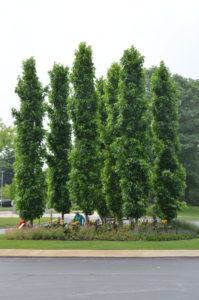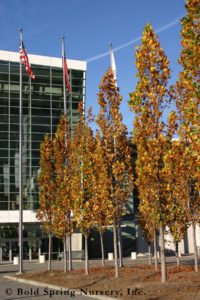There is an old saying that they’re not making more land. This is particularly true in urban downtown areas where room to grow street trees is very limited. Here are four tall trees that also have a striking vertical accent. Their branching is upright. Because of their tall stature, they are particularly suitable planted along wide avenues or boulevards in urban areas. All 4 species adapt well to urban environs. They’re also perfect for small planting sites with no height restrictions (USDA hardiness zones 5-9).
During the first two years following planting, all street trees should be irrigated during dry spells (or very 2-3 weeks) from spring through late summer.
‘Slender Silhouette’ Sweetgum (Liquidambar styraciflua ‘Slender Silhouette’) (USDA 5-9) is a columnar 35 to 50 feet tree that spreads only 8 feet wide. ‘Slender Silhouette’ produces very few nuisance gumball fruits so typical for sweetgum trees. Yellow to red fall color is exceptionally nice. Bark develops deep furrows as the tree matures.
‘Beacon’ Swamp White Oak (Quercus bicolor Beacon) deserves more recognition. ‘Beacon’ is a tightly columnar cultivar with upright branches and mostly disease-free foliage compared to the species. Fall color is yellow and persists for 2 to 4 weeks. Its mature height is 30 to 40 feet and 12 to 15 feet wide. This oak produces acorns which might be a messy problem every 3 or 4 years unless picked up regularly curbside.
‘Princeton Sentry’ or ‘Fastigiata’ Ginkgo (Ginkgo biloba ‘Princeton Sentry’) is a deciduous conifer (a true gymnosperm) that grows to 30-50 feet in height, although a rare mature 100 feet trees is possible after a century or more. It features distinctive two-lobed, triangular or fan-shaped green summer leaves. Male trees (fruitless) should only be planted. Foliage turns bright yellow in fall. In most years, leaves drop rapidly and form a golden carpet around the tree.
‘Arnold’ tulip poplar (Liriodendron tulipifera ‘Arnold’) is a upright (fastigiate) grower to 50-60 feet tall and 8 to 10 feet wide. Unusual light green and orange tulip-like flowers appear in late spring, most blooms hidden under tree’s foliage. Fruits (seed pods) have no value ornamentally. The furrowed gray bark is showy and offers significant winter interest.



 Posted in
Posted in 
